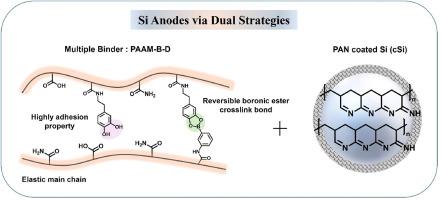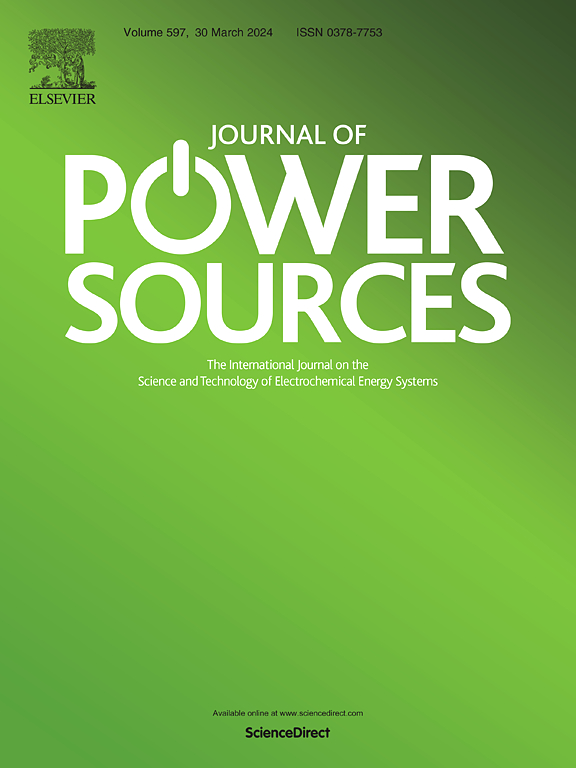Si anodes via dual strategies of coating Si with a rigid polymer and employing a polymer binder with improved mechanical properties
IF 8.1
2区 工程技术
Q1 CHEMISTRY, PHYSICAL
引用次数: 0
Abstract
Si undergoes significant volume change over cycles which degrades the structural integrity and stability of the electrode. This volume change is the primary barrier to the commercialization of Si anodes, and it is more pronounced for Si particle sizes over 150 nm. In this study, a crosslinked polymer binder is developed using poly(acrylic acid-co-acrylamide) (PAAM) with enhanced elasticity compared to the widely used poly(acrylic acid). PAAM is further grafted with boronic acid and dopamine, yielding PAAM-B-D, a binder with improved adhesion due to its 3D crosslinked network. Additionally, 350-nm Si is coated with cyclized polyacrylonitrile (cPAN) and heat-treated to form a conjugated structure. The cPAN-coated Si (cSi) exhibits enhanced conductivity and mechanical stiffness and is used as an active material. The developed Si anode effectively combines cPAN-coated Si with the crosslinked network formed in the PAAM-B-D polymer for enhanced adhesion. The cSi@PAAM-B-D electrode sufficiently maintains its structural integrity and mitigates the Si volume change even with the large-sized 350-nm Si. The cSi@PAAM-B-D exhibits a high initial Coulombic efficiency of 86.5 %, at a Si mass loading of 2 mg cm−2. It also shows a capacity retention of 83.6 % and a high areal capacity of 3 mAh cm−2 after 50 cycles.

通过在硅表面涂覆硬质聚合物和使用具有更佳机械性能的聚合物粘合剂的双重策略实现硅阳极
硅在循环过程中会发生显著的体积变化,从而降低电极的结构完整性和稳定性。这种体积变化是硅阳极商业化的主要障碍,对于粒径超过 150 nm 的硅来说,这种变化更为明显。在本研究中,使用聚(丙烯酸-丙烯酰胺)(PAAM)开发了一种交联聚合物粘合剂,与广泛使用的聚(丙烯酸)相比,该粘合剂具有更强的弹性。PAAM 与硼酸和多巴胺进一步接枝,生成 PAAM-B-D,这种粘合剂因其三维交联网络而具有更好的粘附性。此外,还在 350 纳米的硅上涂覆环化聚丙烯腈(cPAN)并进行热处理以形成共轭结构。经 cPAN 涂层处理的硅(cSi)具有更强的导电性和机械刚度,可用作活性材料。所开发的硅阳极有效地将 cPAN 涂层硅与 PAAM-B-D 聚合物中形成的交联网络结合在一起,从而增强了附着力。cSi@PAAM-B-D 电极能充分保持结构的完整性,即使使用 350 纳米的大尺寸硅也能减轻硅体积的变化。在硅质量负载为 2 mg cm-2 时,cSi@PAAM-B-D 的初始库仑效率高达 86.5%。它还显示出 83.6% 的容量保持率和 50 个循环后 3 mAh cm-2 的高电容值。
本文章由计算机程序翻译,如有差异,请以英文原文为准。
求助全文
约1分钟内获得全文
求助全文
来源期刊

Journal of Power Sources
工程技术-电化学
CiteScore
16.40
自引率
6.50%
发文量
1249
审稿时长
36 days
期刊介绍:
The Journal of Power Sources is a publication catering to researchers and technologists interested in various aspects of the science, technology, and applications of electrochemical power sources. It covers original research and reviews on primary and secondary batteries, fuel cells, supercapacitors, and photo-electrochemical cells.
Topics considered include the research, development and applications of nanomaterials and novel componentry for these devices. Examples of applications of these electrochemical power sources include:
• Portable electronics
• Electric and Hybrid Electric Vehicles
• Uninterruptible Power Supply (UPS) systems
• Storage of renewable energy
• Satellites and deep space probes
• Boats and ships, drones and aircrafts
• Wearable energy storage systems
 求助内容:
求助内容: 应助结果提醒方式:
应助结果提醒方式:


